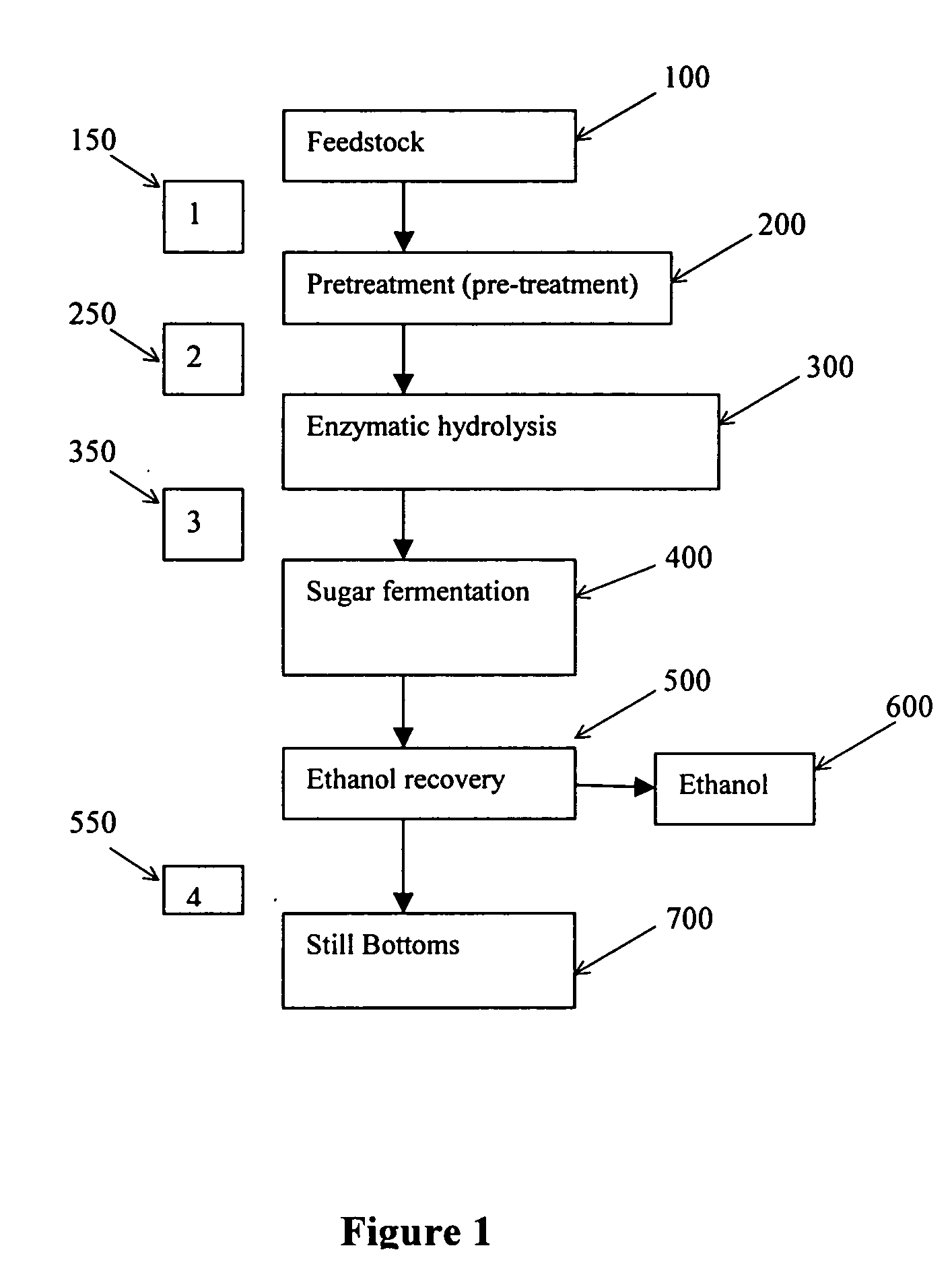Recovery of inorganic salt during processing of lignocellulosic feedstocks
- Summary
- Abstract
- Description
- Claims
- Application Information
AI Technical Summary
Benefits of technology
Problems solved by technology
Method used
Image
Examples
example 1
Recovery of Soluble Inorganic Salt from a Hydrolyzate Sugar Stream
[0131] A sugar hydrolyzate stream containing sodium sulfate and other soluble inorganic salts was prepared as follows.
Feedstock Preparation
[0132] Wheat straw was received in bales measuring 3 feet by 3 feet by 4 feet. The wheat straw consisted of 60.3% carbohydrates, 18.7% lignin, 3.6% protein, 3.1% silica, and 4.9% non-silica inorganic salts. The inorganic salts included the cationic salt ions potassium (1.2%), calcium (0.57%), sodium (0.04%) and magnesium (0.15%), and the anionic ions chloride (0.22%) and phosphate (0.04%). The organic salt oxalate was also present at a concentration of 0.51%.
[0133] Two batches of 15 tonnes of the straw were hammer-milled to an average size of ⅛″ and slurried in water at a ratio of 10 parts water to 1 part solids. The slurry was pumped through piping heated by direct injection with 350 psig steam to reach a temperature of 1 85° C. Once at this temperature, 10% sulfuric acid was...
example 2
Recovery of Soluble Inorganic Salt from Wheat Straw Leachate
[0143] Wheat straw was received in bales measuring 3 feet by 3 feet by 4 feet. The wheat straw consisted of 15.9% moisture. The composition of the straw, on a dry basis, was 60.1% carbohydrates, 19.7% lignin, 3.36% protein, 3.0% silica, and 4.5% non-silica salts. The inorganic cationic salt ions included 1.28% potassium, 0.45% calcium, 0.04% sodium, and 0.15% magnesium. The inorganic anions were chloride at 0.22% and 0.04% phosphate. The organic salt oxalate was present at a concentration of 0.55%. A weight of 1199 kg wet straw was hammer-milled to ⅛ inch.
[0144] The hammer-milled straw was slurried in 49,590 liters of 65° C. water. The slurry was gravity fed into a mixed tank, where it was mixed overnight for 18 hours and maintained at 65° C. The pH was 6.4 throughout the leaching process. The slurry was then flowed through screened baskets by gravity to separate the solids from the liquid leachate stream. The screened ba...
example 3
Recovery of Soluble Inorganic Salts from Wheat Straw Leachate
[0149] Wheat straw was received in bales measuring 3 feet by 3 feet by 4 feet. The wheat straw consisted of 6.4% moisture. The composition of the straw, on a dry basis, was 60.3% carbohydrates, 18.7% lignin, 3.6% protein, 3.1% silica, and 4.9% non-silica salts. The inorganic cationic salt ions present included 1.22% potassium, 0.57% calcium, 0.04% sodium, and 0.15% magnesium. The inorganic anions were chloride at 0.10%, 0.16% phosphate and 0.08% sulfate. A weight of 3,363 kg of moist straw was hammer-milled to ⅛ inch pieces. The hammer-milled straw was slurried in 70,626 liters of 65° C. water. The slurry was gravity fed into a mixed tank, where it was mixed overnight for 18 hours and maintained at 65° C. The pH was 4.9 throughout the leaching process. The slurry was then flowed through a centrifuge to separate the solids from the liquid leachate stream. The centrifuge produced a cake of 29.6% solids content.
[0150] The l...
PUM
| Property | Measurement | Unit |
|---|---|---|
| Temperature | aaaaa | aaaaa |
| Temperature | aaaaa | aaaaa |
| Fraction | aaaaa | aaaaa |
Abstract
Description
Claims
Application Information
 Login to View More
Login to View More - R&D
- Intellectual Property
- Life Sciences
- Materials
- Tech Scout
- Unparalleled Data Quality
- Higher Quality Content
- 60% Fewer Hallucinations
Browse by: Latest US Patents, China's latest patents, Technical Efficacy Thesaurus, Application Domain, Technology Topic, Popular Technical Reports.
© 2025 PatSnap. All rights reserved.Legal|Privacy policy|Modern Slavery Act Transparency Statement|Sitemap|About US| Contact US: help@patsnap.com

